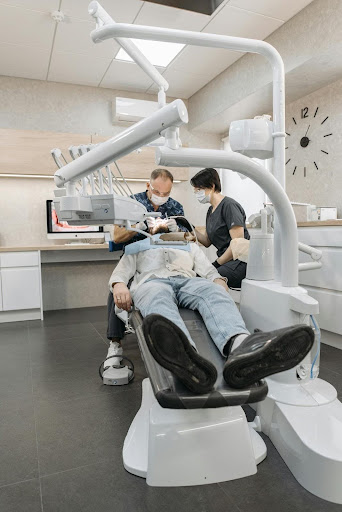Understanding the Process of Teeth Aligners and Whitening
Want straighter teeth and a whiter smile without metal braces?
You’re not alone. Millions of people each year are choosing clear teeth aligners and teeth whitening treatments as a solution to get the smile they’ve always wanted. And here’s the thing…
Teeth aligners are easier to get and more effective than ever. Modern science and technology now make it possible to straighten your teeth and whiten your smile at the same time. The best part is that the entire process is much easier than you may think.
Here’s a breakdown of everything you need to know.
- How Do Teeth Aligners Work?
- The Science Behind Teeth Whitening
- Combining Teeth Aligners and Whitening
- What to Expect During Treatment
Teeth Aligners Process: How Straight Teeth Work
Teeth aligners have revolutionized the world of orthodontics.
Clear aligners are a virtually invisible alternative to traditional metal braces and, you guessed it, you can take them off when you brush your teeth or eat food. According to market data, the global clear aligners market size was valued at $6.49 billion in 2024 and it’s been rapidly growing as awareness spreads.
So, let’s break down how they work.
You begin by going to a reputable dental clinic in Leichhardt or a clinic near you where the dentist will use advanced 3D imaging equipment to scan your teeth and create a digital copy of your bite and smile. This digital scan is the foundation for all of your treatment plans and teeth aligners and teeth whitening solutions that are custom made just for you.
The dentist uses your scan to calculate the precise movements your teeth need to make over time. They will then use that information to create a series of custom aligners that shift your teeth incrementally into their final positions. Each aligner is worn for 1 to 2 weeks before moving on to the next set in the series.
It’s really that simple.
Clear aligners are backed by cutting-edge dental technology that carefully applies small amounts of pressure to individual teeth at precise times in the treatment. It’s this level of accuracy that makes them so effective at achieving your goals.
The Teeth Whitening Process: What’s the Big Deal?
Let’s talk whitening now…
Teeth whitening is one of the most popular cosmetic dental procedures in the world right now. Data from a recent survey shows 52% of adults consider tooth brightness one of their top oral health priorities, which explains why the teeth whitening market is forecast to reach $8.52 billion in 2024.
There are two main types of teeth whitening.
Professional whitening services are usually performed in your dentist’s office. They use a high-concentration bleaching gel that your dentist applies to your teeth. They may also use a special light or laser to activate the gel and accelerate the whitening process. You may see results after just one visit, but some people require multiple appointments for best results.
At-home whitening is a more gradual approach that uses custom-fit trays worn for a specific amount of time each day. Your dentist will provide you with professional-grade whitening gel, which is stronger than over-the-counter brands but gentler than in-office treatments.
Both of these methods use oxygen-based peroxide formulas that break down the stains on your teeth into smaller pieces. Oxygen molecules from the peroxide penetrate the enamel and break apart the bonds that cause discoloration.
Neat, huh?
Teeth Aligners and Whitening: Why Are They Paired?
Here’s a little secret…
Teeth aligners and whitening treatments are one of the smartest moves you can make for your smile. Here’s why: if you’re going to the effort and expense to straighten your teeth, it makes sense to fix discoloration while you’re at it.
Timing is important, though. Most dentists recommend waiting until your aligner treatment is finished before getting professional whitening done. Here’s why:
Your teeth should be in their final positions before whitening to get even color throughout the entire mouth. Whitening while your teeth are still moving can result in patchy, uneven areas where the aligners were.
But that doesn’t mean you have to wait years to achieve a brighter smile. You can use whitening toothpaste during your aligner treatment to maintain your current shade and prevent new stains from developing.
What’s Involved in Treatment: Your Timeline
Ok, let’s get down to brass tacks…
- Months 1-3: You’ll start wearing your first few sets of aligners and get used to the feel of them. Your teeth may feel slightly sore at first, as they start to shift into place, but that is normal and will subside over time.
- Months 4-8: You’re really in the thick of treatment now. Your teeth are actively moving, and you should start to see visible progress. It’s at this point when many people start getting excited about their results.
- Months 9-12: You’re in the home stretch. Your teeth are in their final positions and you’re just counting down to your last aligner.
- Month 13+: Aligner treatment complete! Now you can do your whitening if you choose to. Professional whitening can be completed right after your treatment ends.
Treatment for teeth aligners can take 12-18 months in total, depending on your teeth’s starting position and how much movement is required. Adding teeth whitening treatments can take another 1-3 weeks if you opt for at-home solutions or a few hours for in-office procedures.
Keeping Results: Teeth Long-Term Care
Here’s the secret to making sure your results last…
Maintenance and care. After all of that time and money invested in teeth aligners and teeth whitening, you need to protect that investment. Here’s how to maintain the process:
- Wear Your Retainer – Teeth naturally shift back to their original positions. A retainer prevents teeth from moving before the bone and tissues surrounding them fully stabilize.
- Avoid Staining Foods – Things like coffee, red wine, and dark berries can quickly reverse your teeth whitening results. If you must drink them, rinse your mouth with water after.
- Practice Good Hygiene – Brushing twice a day and flossing once a day are the best ways to prevent new stains from developing and keep your teeth healthy.
- Touch-Up Whitening – Most people will need touch-up whitening every 6-12 months to keep teeth brightness at its peak. Custom trays provided by your dentist make it easy to do at home.
The better you treat your teeth, the longer your results will last.
Costs and Insurance: Why Doesn’t Insurance Cover Teeth?
So, what’s the question on everyone’s mind…
How much does this cost? Teeth aligner treatment averages between $3,000 and $8,000, depending on the complexity of your case. Whitening can cost another $300 to $1,000, depending on the type of service you receive.
Some dental insurance providers will cover a portion of the cost of teeth aligners if deemed medically necessary. Teeth whitening is usually cosmetic and not covered. However, most dental clinics offer financing plans that make the treatments more affordable.
It is a worthwhile investment, though. You aren’t just getting straighter and whiter teeth. You are regaining confidence that is visible to everyone you talk to, every photo you take, and every time you smile.
Conclusion
Teeth aligners and teeth whitening treatments have helped millions of people all over the world transform their smiles. The process is simple, the results are dramatic, and the increase in confidence is invaluable.
Whether you do both treatments or just one of them, you’re making a positive change toward the smile you’ve always wanted. Technology is tried and tested, the process is easy, and the results speak for themselves.
It’s never too late to start. Find a trusted dentist or dental professional who can take you through the process and show you how to get the smile you’ve always wanted. It’s closer than you think.
Keep an eye for more latest news & updates on Wellhealth Organic!






